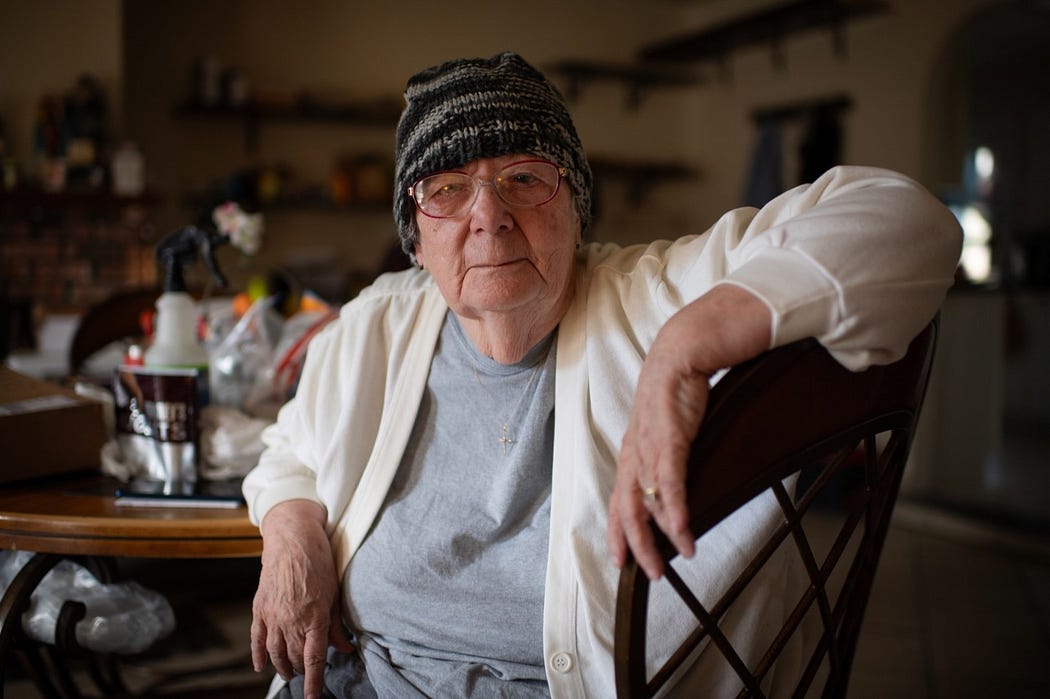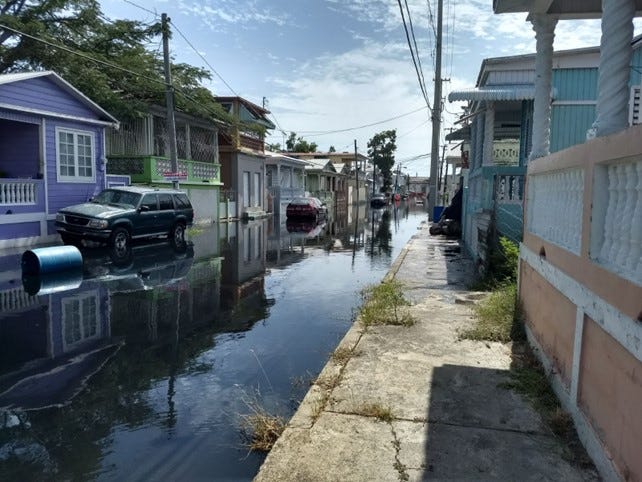Threatened by Toxics, Some Communities Look for a Buy-Out: But will Trump’s FEMA Prevent it?
In August 2016, Susan Liley stood on a hilltop as her hometown flooded below. She watched in horror, but no longer surprised. This was De Soto’s fourth flood in three years. A crowded signpost memorializes each high-water mark. December 28,

In August 2016, Susan Liley stood on a hilltop as her hometown flooded below. She watched in horror, but no longer surprised. This was De Soto’s fourth flood in three years. A crowded signpost memorializes each high-water mark. December 28, 2015: 12’ 5”. May 3, 2013: 13’. August 15, 2016: 14’. Last November, on Election Day, De Soto flooded again.

Susan Liley in De Soto, MO. Photo by Anthony Meyers
“You can’t tell me this isn’t a bad place to live,” Liley said of the railroad town in eastern Missouri. Sure, its historic buildings are beautiful. Most of her neighbors are loving and kind. Even the train graffiti has its charm. But hundreds of homes in De Soto are no longer safe.
Fifteen dams dot the eight miles upcreek. “The potential for disaster is right here, all the time,” Liley said. And it comes.
In 2003, a young father trapped in his car was washed past a drainage tube and drowned. In 2013, flash floods swept an 80-year-old woman off Veterans Drive to her death. In 2016, a homebound woman was evacuated by boat only to suffer a heart attack and die the next day.
“This is ridiculous,” Liley thought as the water cleared in 2016. “I got tired of looking and not doing anything.” That’s when she started the Citizens’ Committee for Flood Relief (CCFR).
“Through flood sweat and tears, De Soto stays strong,” is emblazoned across the group’s blue T-shirts, but strength only goes so far in a flood plain surrounded by Superfund sites.
“We have lots of lead,” Liley said, listing several old mines in and around Jefferson County. “People on the creek are always sick and dying of cancer.” New hazards aren’t helping. A Union Pacific rail yard sits at De Soto’s center. It used to flood contaminants into the creek. Now they wash towards Main Street.
As climate change brings more severe and frequent flooding to De Soto, the risk of catastrophic loss and flood-borne pollution grows. Many homeowners want out.
CCFR is working with Anthropocene Alliance (A2), Buy-In Community Planning, Climigration Network, and government experts to implement a floodplain management plan and secure “buyouts.”
Buyouts are often the last best option for homes that repeatedly flood. They occur when homeowners voluntarily sell their properties to government entities at pre-disaster fair market value. In most cases, the acquired structures are demolished and the land becomes open space to prevent new construction in the risk zone. Since 1989, the Federal Emergency Management Agency (FEMA) has partnered with local and state governments to buy out roughly 50,000 homes across the U.S.
“Buyouts are important because they provide homeowners an option that often isn’t on the table,” said A.R. Siders, director of the University of Delaware’s Climate Change Science and Policy Hub.
“Without buyout programs, people can feel stuck, like their only option is to sell to another family and put them in the same position or stay in a home that repeatedly floods, maybe a home where people have lost loved ones, or where kids have PTSD from past flooding.”
Last year De Soto received state and federal funding to buy and demolish five flood-prone homes, adding to the 19 properties it had already acquired and destroyed. According to the city’s floodplain management plan, about 350 homes and more than 100 businesses remain at risk.
As of December 2024, 30 different federal agencies were authorized to support community recovery following natural disasters. Siders says this spider’s web of programs can confuse homeowners and pose administrative burdens for local governments, but it also provides flexibility to acquire homes that face multiple risks.

Barbara Weckesser in her home in Pascagoula, MS. Photo by Rory Doyle.
Pascagoula floods — 90 percent of the Mississippi city was under water when Hurricane Katrina came ashore in 2005 — but high tides aren’t the main reason A2 member Cherokee Concerned Citizens (CCC) wants buyouts. Founder Barbara Weckesser says her Cherokee Forest subdivision, which sits on the fenceline of an industrial hub, is polluted beyond repair.
“We get moolene, toolene, and boolene, all kinds of different chemicals,” Weckesser jokes (of those only toluene, a toxic irritant, exists and affects the community). “We can’t narrow down which company is polluting what because they use the same things. Benzene, sulfur, sulfuric acid, coke dust, paint fumes, sandblasting dust. Children’s toenails are testing positive for nickel.”
A massive Chevron refinery sits a quarter mile across the bayou from Weckesser’s home. Closer still are the Bollinger shipyard and building facilities. Other neighbors include the Destin gas pipeline, an Enterprise Gas plant that exploded in 2016, and the Mississippi Phosphates Superfund Site.
“People move in because they can’t afford to buy anywhere else,” Weckesser said. “Renters come, stay six months or a year, and then they’re gone.”
CCC was formed in 2013 to protect the community from pollution. After deciding their homes were no longer safe (and years spent running into walls with the City), members began working with Buy-In to explore relocation options including voluntary buyouts. In 2024, Buy-In received funding through the National Fish and Wildlife Foundation to help CCC develop a buyout strategy that would benefit the whole community and restore native Gulf Coast landscapes on acquired plots. The plan aims to improve ecosystem health and provide an ecological buffer to protect remaining homes and businesses from hurricanes, sea level rise, and ongoing industrial pollution. More pressingly, it aims to get people out.
In a recent survey, 90 percent of Cherokee Forest’s 120 households were considering buyouts.
“People are tired of being sick, tired of the noise, tired of getting hit with some smell that takes your breath away every time you go outside,” Weckesser said. “One woman told me ‘Just buy me out, I’ll figure out where to go later.’”
Weckesser, 77, wants to return to Kentucky where she grew up and where her two sons still live.
“My kids are throwing a fit for me to come ASAP,” she said. “I tell them, ‘Boys, I can’t come home.’ I live in a house I shouldn’t be in, I can’t sell, and I can’t rent. I’m forced to stay until we can get a buyout.”
“It’s not just about money and rehousing, but thinking about the whole person, the community, and their social well-being,” said Kelly Main, Buy-In’s Executive Director. “We’re trying to build a relocation assistance program grounded in people’s needs.”
To surface these needs, Buy-In and community groups design and implement locally relevant surveys together then analyze the data to determine how best to move forward. Sometimes this means working with homeowners and local governments to apply for grants and implement buyouts.
Other A2 members Buy-In works with include: Local Environmental Action Demanded (LEAD) Agency in Oklahoma where the Tar Creek Superfund Site floods Indigenous communities and other residents with hazardous mining waste; the Greater Birmingham Alliance To Stop Pollution (GASP) in Alabama where air pollution from steel mills and coke plants is pushing relocation plans; and Un Nuevo Amanecer (UNA) in Puerto Rico where flooding causes hazardous sewage water to back up in the streets.

A flooded community in Barrio Playa in Ponce, on Puerto Rico’s south coast. Sewage tainted storm waters regularly inundate Puerto Viejo street. Photo by Ludwig Medina.
David Southgate, an activist and volunteer with UNA, said his neighborhood Playa de Ponce has experienced buyouts and property acquisitions from various agencies in various forms since the early 1980s.
“There’s a long list of neighborhoods that no longer exist,” Southgate said. “In general, people don’t speak about these displacement programs that have ignored the social fabric they’re breaking up and that don’t make people whole.”
These oversights are what motivated Main to start Buy-In. “Traditional post-disaster programs ask, ‘Do people fit the eligibility of this program?’” Main said. “Buy-In asks, ‘Does the program fit the needs of the people?’” This holistic approach to relocation planning helps communities understand their overlapping risks and options.
In a promising sign the federal government might follow suit, the White House issued a first-of-its-kind report in December that addressed both climate- and pollution-driven relocation together.
“The [Biden-Harris] Administration recognizes that not only are the risks and impacts of climate change and legacy contamination disproportionately concentrated in Tribal Nations and other communities with environmental justice concerns, but that these communities often face a steeper road to recovery when disaster strikes,” the report stated.
Published during the previous administration’s lame duck winter, the report is filled with “wills” (e.g. “The Federal government will use the following principles to support community-driven relocation”) and other promises the Trump administration looks unlikely to keep.
In early February, the report (reposted here) was no longer available on the White House’s website. Information about the Office of Environmental Justice and External Civil Rights (OEJECR) was still on the EPA’s site, but with 170 of its employees now placed on administrative leave, this may too become a broken link.
Purged web pages and chaotic closures spell uncertainty for the federal government’s commitment to environmental justice. When President Trump illegally froze then unfroze up to $3tn in federal grants and loans in late January, many nonprofits, including A2 partners and members, were left confused or in limbo.
“We get a lot of funding through the National Fish and Wildlife Foundation, so if that gets cut, all of our programs would stop,” Main said. “I’d have to go out and fundraise.”
“The freezing and unfreezing has created so much uncertainty,” Siders said. “No one wants to spend money from a grant and then it gets recalled. I expect we’ll see delays in money being spent and lower spending rates while people wait for certainty.”
Whatever the new administration thinks about climate change, homes will continue to flood.
By 2045, more than 300,000 residential properties along the U.S. coast are at risk of chronic flooding from sea rise alone.
“That’s not once a year or every couple of years. We’re talking chronic, disruptive flooding. Roads washed out, properties in high-tide zones. You’re basically living in Venice,” Main said. “So if FEMA has done 50,000 buyouts in the last 35 years, there’s no way to scale the current system to address even these most at-risk homes.”
With federal funding in flux, Main is exploring public-private partnerships, state and local grants, and philanthropic support to continue buyout planning with communities desperate to move.
“When we help people get out of harm’s way and find a secure and stable place to live, we break the disaster recovery cycle,” Main said. “When multiple actors ‘buy in’ to the buyout process, we can create a permanent solution for eliminating people’s flood risk.”
De Soto offers proof.
“There was a couple who lived with their grandchildren in a beautiful brick house along the creek,” Liley said. A couple of years ago, their grandson had an asthma attack at the Thanksgiving table. The doctor told the boy he could no longer live with Grandma and Grandpa — too much mold in their flooded house. The couple accepted a buyout last year and moved to a new home above the floodplain. In December, the whole family celebrated the holidays together, high and dry.
Read the full article at the original website
References:
- https://anthropocenealliance.org/citizens-committee-for-flood-relief/
- https://anthropocenealliance.org/
- https://buy-in.org/
- https://www.climigration.org/
- https://anthropocenealliance.org/cherokee-concerned-citizens/
- https://www.csb.gov/csb-releases-final-report-into-2016-pascagoula-gas-plant-explosion/
- https://cumulis.epa.gov/supercpad/cursites/csitinfo.cfm?id=0403508
- https://anthropocenealliance.org/lead-agency/
- https://anthropocenealliance.org/greater-birmingham-alliance-to-stop-pollution-gasp/
- https://anthropocenealliance.org/un-nuevo-amanecer-inc/
- https://www.whitehouse.gov/wp-content/uploads/2024/12/Opportunities-for-Federal-Support-of-Community-Driven-Relocation-vF.pdf
- https://indianz.com/News/wp-content/uploads/2024/12/09/Opportunities-for-Federal-Support-of-Community-Driven-Relocation-vF.pdf
- https://www.npr.org/2025/02/06/nx-s1-5289331/epa-employees-who-work-on-environmental-justice-are-put-on-leave
- https://www.epa.gov/aboutepa/about-office-environmental-justice-and-external-civil-rights
- https://time.com/7211965/trump-federal-websites-data/
- https://www.theguardian.com/commentisfree/2025/jan/30/trump-chaos-funding-freeze
- https://www.ucsusa.org/sites/default/files/attach/2018/06/underwater-analysis-full-report.pdf
- https://bsky.app/intent/compose?text=Threatened%20by%20Toxics%2C%20Some%20Communities%20Look%20for%20a%20Buy-Out%3A%20But%20will%20Trump%E2%80%99s%20FEMA%20Prevent%20it%3F+https%3A%2F%2Fwww.resilience.org%2Fstories%2F2025-03-17%2Fthreatened-by-toxics-some-communities-look-for-a-buy-out-but-will-trumps-fema-prevent-it%2F
- https://x.com/intent/tweet?text=Threatened%20by%20Toxics%2C%20Some%20Communities%20Look%20for%20a%20Buy-Out%3A%20But%20will%20Trump%E2%80%99s%20FEMA%20Prevent%20it%3F&url=https%3A%2F%2Fwww.resilience.org%2Fstories%2F2025-03-17%2Fthreatened-by-toxics-some-communities-look-for-a-buy-out-but-will-trumps-fema-prevent-it%2F
- https://www.linkedin.com/shareArticle?url=https%3A%2F%2Fwww.resilience.org%2Fstories%2F2025-03-17%2Fthreatened-by-toxics-some-communities-look-for-a-buy-out-but-will-trumps-fema-prevent-it%2F&title=Threatened%20by%20Toxics%2C%20Some%20Communities%20Look%20for%20a%20Buy-Out%3A%20But%20will%20Trump%E2%80%99s%20FEMA%20Prevent%20it%3F&summary=Buyouts%20are%20often%20the%20last%20best%20option%20for%20homes%20that%20repeatedly%20flood.%20They%20occur%20when%20homeowners%20voluntarily%20sell%20their%20properties%20to%20government%20entities%20at%20pre-disaster%20fair%20market%20value.&mini=true
